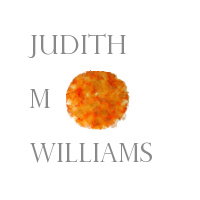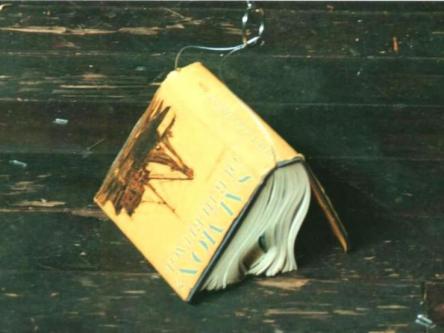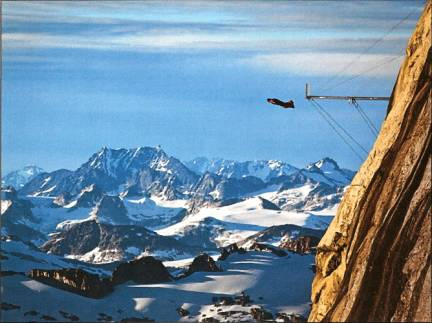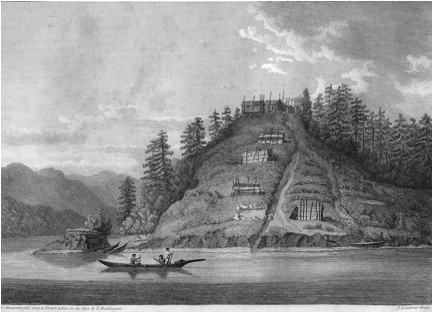this is the story of...
"this is the story of . . . ", a video of the destruction of the book: Salmon Our Heritage, at the Goose Bay Cannery, Rivers Inlet, 2001.
The 16 minute video “this is the story of. . .” records the mechanical destruction of the book Salmon Our Heritage at the Goose Bay Cannery July 2001. Built in 1926, the Goose Bay Cannery was once part of a string of salmon processing plants from Steveston to Alaska. Now redundant, its canning equipment is dispersed between the North Pacific Cannery Village Museum at Port Edward south of Prince Rupert and the Gulf of Georgia Cannery Museum in Steveston. The video of Salmon Our Heritage repeatedly dropped and destroyed by a programmed winch was made for Salmon Stock, a two-part exhibition curated by Corrine Corry for the Richmond Art Gallery and the Gulf of Georgia Cannery Museum in September, 2003. It was shown as a loop at Richmond alongside reports, by members of the Desolation Sound Salmon Enhancement Society, of the first return of Coho from our salmon project. A vitrine contained the remains of the destroyed copy of Salmon Our Heritage.
Judith Williams: 1 of 2 from C. Kelley on Vimeo.
Judith Williams 2 of 2 from C. Kelley on Vimeo.
By “Rivers Day”, September 28, 2003, a video was recording the winch dropping and destroying a second copy of Salmon Our Heritage in the Boiler Room Theater of the Gulf of Georgia Cannery Museum between showings of a film on the history of the museum. A public round table discussion of the relationship of the project to salmon research, salmon farming and salmon future was held at the museum. While “this is the story of . . .” was shot in an empty shuttered venue, the new video “shadow” records the book’s destruction on an active public set. The video imagery is undercut by the repeated sigh of the boiler itself.
Material for Salmon Stock' section three: “net”, was shot at the North Pacific Cannery Village Museum at Port Edward. This video is built around the image of a woman shortening a net at Port Edward in 2001 when fishermen were directed by the Department of Fisheries and Oceans to use half nets in truncated ½ hour sets due to a shortage of salmon in the Skeena River, one of the BC coast’s major salmon runs.
Salmon Stock grew from my work as Chairman of the Desolation Sound Salmon Enhancement Society which has cleaned and rehabilitated five salmon streams on West Redonda Island. In the process of learning the salmon system and studying the relevant literature, I found acres of reports, interminable “briefs” to the government and beautiful pictures of what was being destroyed. Salmon, I believe, have been studied to death and many careers, both academic and bureaucratic, have been built on the backs of dwindling salmon stocks. I could not shake the sense that the accumulation of paper had helped destroy the stocks and that paper salmon were replacing the salmon cycle.
The book I chose to illustrate this, Salmon Our Heritage, is a lushly produced effort by Cecily Lyons, secretary to various salmon industry executives. A sober effort to document the industry, it ignores eons of native harvesting and fish management techniques and nowhere gives voice to those of actual fishers who, during our round table at Steveston, spoke eloquently of their experience. The book’s title and its content made it an ideal actor for the performance. The robustly sewn binding provided for a slow and painful-appearing demise that mimicked the initially subtle and then accelerating stock loss.
The increasing readability of the book available during its baroque deconstruction seemed to parallel my understanding of the salmon cycle and the physical decline of salmon reentering fresh water when their compromised immune systems can cause the loss of skin and flesh in the still swimming fish. After spawning, their decomposing bodies feed a series of other creatures some of who will provide sustenance for young salmon. Most people find the destruction of books abhorrent. It is my hope that the viewers of Salmon Stock find the destruction of salmon stocks and habitat equally objectionable and that they acquire the strength to influence our scientific, business and political leaders to preserve one of the wonders of the world. Thanks to Phyllis Reeve and Caffin Kelly at islandsinstitute.com.




